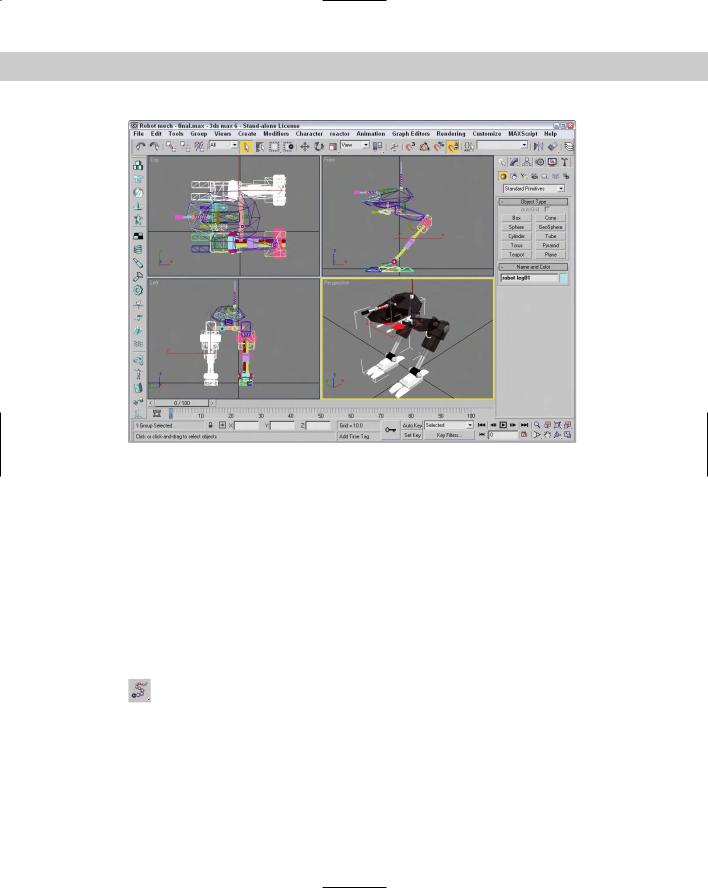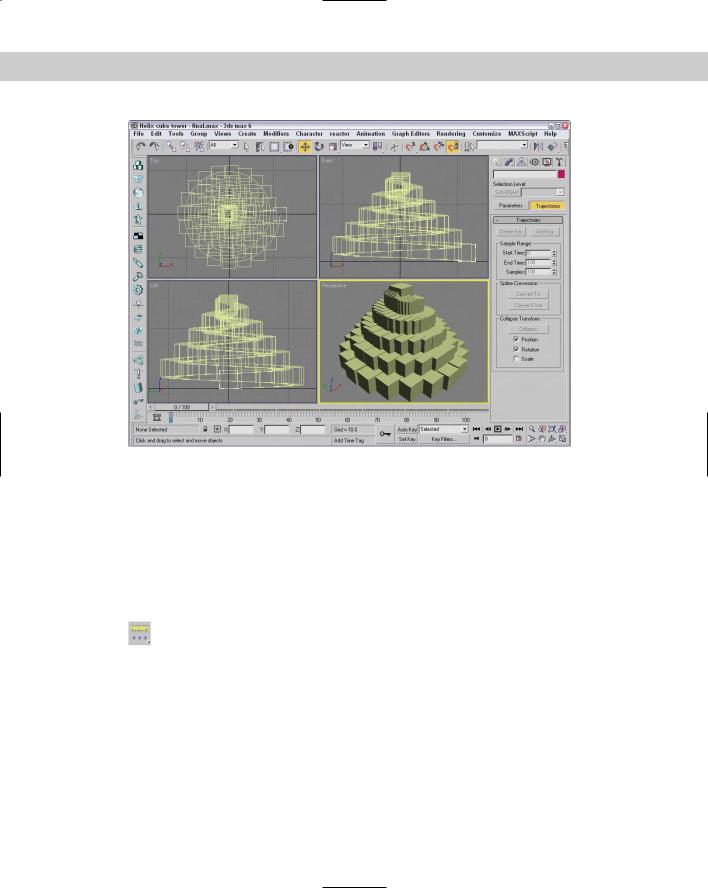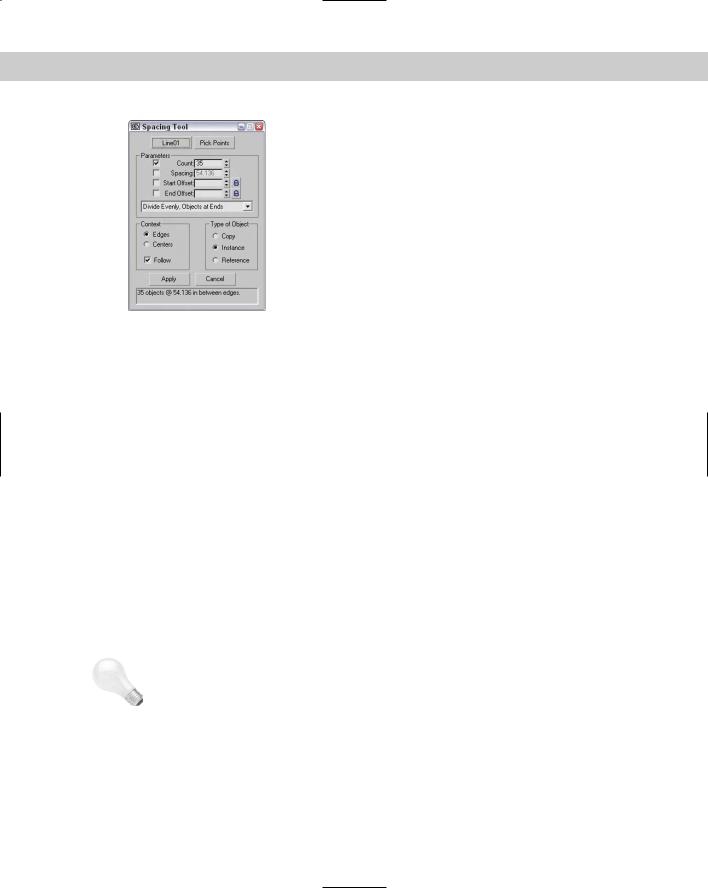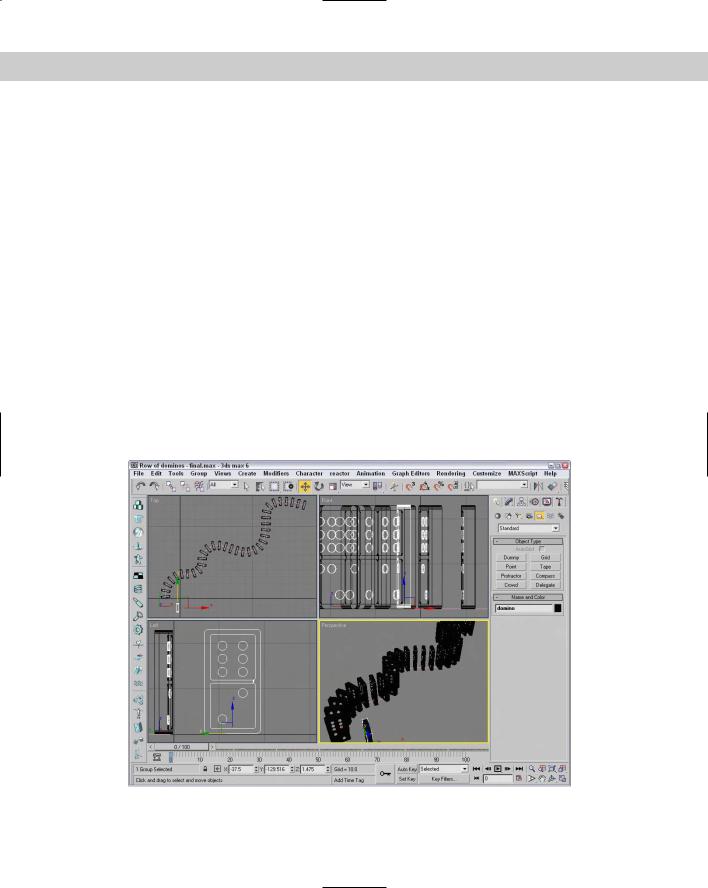
- •Preface
- •About This Book
- •Acknowledgments
- •Contents at a Glance
- •Contents
- •Relaxing at the Beach
- •Dressing the Scene
- •Animating Motion
- •Rendering the Final Animation
- •Summary
- •The Interface Elements
- •Using the Menus
- •Using the Toolbars
- •Using the Viewports
- •Using the Command Panel
- •Using the Lower Interface Bar Controls
- •Interacting with the Interface
- •Getting Help
- •Summary
- •Understanding 3D Space
- •Using the Viewport Navigation Controls
- •Configuring the Viewports
- •Working with Viewport Backgrounds
- •Summary
- •Working with Max Scene Files
- •Setting File Preferences
- •Importing and Exporting
- •Referencing External Objects
- •Using the File Utilities
- •Accessing File Information
- •Summary
- •Customizing Modify and Utility Panel Buttons
- •Working with Custom Interfaces
- •Configuring Paths
- •Selecting System Units
- •Setting Preferences
- •Summary
- •Creating Primitive Objects
- •Exploring the Primitive Object Types
- •Summary
- •Selecting Objects
- •Setting Object Properties
- •Hiding and Freezing Objects
- •Using Layers
- •Summary
- •Cloning Objects
- •Understanding Cloning Options
- •Mirroring Objects
- •Cloning over Time
- •Spacing Cloned Objects
- •Creating Arrays of Objects
- •Summary
- •Working with Groups
- •Building Assemblies
- •Building Links between Objects
- •Displaying Links and Hierarchies
- •Working with Linked Objects
- •Summary
- •Using the Schematic View Window
- •Working with Hierarchies
- •Setting Schematic View Preferences
- •Using List Views
- •Summary
- •Working with the Transformation Tools
- •Using Pivot Points
- •Using the Align Commands
- •Using Grids
- •Using Snap Options
- •Summary
- •Exploring the Modifier Stack
- •Exploring Modifier Types
- •Summary
- •Exploring the Modeling Types
- •Working with Subobjects
- •Modeling Helpers
- •Summary
- •Drawing in 2D
- •Editing Splines
- •Using Spline Modifiers
- •Summary
- •Creating Editable Mesh and Poly Objects
- •Editing Mesh Objects
- •Editing Poly Objects
- •Using Mesh Editing Modifiers
- •Summary
- •Introducing Patch Grids
- •Editing Patches
- •Using Modifiers on Patch Objects
- •Summary
- •Creating NURBS Curves and Surfaces
- •Editing NURBS
- •Working with NURBS
- •Summary
- •Morphing Objects
- •Creating Conform Objects
- •Creating a ShapeMerge Object
- •Creating a Terrain Object
- •Using the Mesher Object
- •Working with BlobMesh Objects
- •Creating a Scatter Object
- •Creating Connect Objects
- •Modeling with Boolean Objects
- •Creating a Loft Object
- •Summary
- •Understanding the Various Particle Systems
- •Creating a Particle System
- •Using the Spray and Snow Particle Systems
- •Using the Super Spray Particle System
- •Using the Blizzard Particle System
- •Using the PArray Particle System
- •Using the PCloud Particle System
- •Using Particle System Maps
- •Controlling Particles with Particle Flow
- •Summary
- •Understanding Material Properties
- •Working with the Material Editor
- •Using the Material/Map Browser
- •Using the Material/Map Navigator
- •Summary
- •Using the Standard Material
- •Using Shading Types
- •Accessing Other Parameters
- •Using External Tools
- •Summary
- •Using Compound Materials
- •Using Raytrace Materials
- •Using the Matte/Shadow Material
- •Using the DirectX 9 Shader
- •Applying Multiple Materials
- •Material Modifiers
- •Summary
- •Understanding Maps
- •Understanding Material Map Types
- •Using the Maps Rollout
- •Using the Map Path Utility
- •Using Map Instances
- •Summary
- •Mapping Modifiers
- •Using the Unwrap UVW modifier
- •Summary
- •Working with Cameras
- •Setting Camera Parameters
- •Summary
- •Using the Camera Tracker Utility
- •Summary
- •Using Multi-Pass Cameras
- •Creating Multi-Pass Camera Effects
- •Summary
- •Understanding the Basics of Lighting
- •Getting to Know the Light Types
- •Creating and Positioning Light Objects
- •Viewing a Scene from a Light
- •Altering Light Parameters
- •Working with Photometric Lights
- •Using the Sunlight and Daylight Systems
- •Using Volume Lights
- •Summary
- •Selecting Advanced Lighting
- •Using Local Advanced Lighting Settings
- •Tutorial: Excluding objects from light tracing
- •Summary
- •Understanding Radiosity
- •Using Local and Global Advanced Lighting Settings
- •Working with Advanced Lighting Materials
- •Using Lighting Analysis
- •Summary
- •Using the Time Controls
- •Working with Keys
- •Using the Track Bar
- •Viewing and Editing Key Values
- •Using the Motion Panel
- •Using Ghosting
- •Animating Objects
- •Working with Previews
- •Wiring Parameters
- •Animation Modifiers
- •Summary
- •Understanding Controller Types
- •Assigning Controllers
- •Setting Default Controllers
- •Examining the Various Controllers
- •Summary
- •Working with Expressions in Spinners
- •Understanding the Expression Controller Interface
- •Understanding Expression Elements
- •Using Expression Controllers
- •Summary
- •Learning the Track View Interface
- •Working with Keys
- •Editing Time
- •Editing Curves
- •Filtering Tracks
- •Working with Controllers
- •Synchronizing to a Sound Track
- •Summary
- •Understanding Your Character
- •Building Bodies
- •Summary
- •Building a Bones System
- •Using the Bone Tools
- •Using the Skin Modifier
- •Summary
- •Creating Characters
- •Working with Characters
- •Using Character Animation Techniques
- •Summary
- •Forward versus Inverse Kinematics
- •Creating an Inverse Kinematics System
- •Using the Various Inverse Kinematics Methods
- •Summary
- •Creating and Binding Space Warps
- •Understanding Space Warp Types
- •Combining Particle Systems with Space Warps
- •Summary
- •Understanding Dynamics
- •Using Dynamic Objects
- •Defining Dynamic Material Properties
- •Using Dynamic Space Warps
- •Using the Dynamics Utility
- •Using the Flex Modifier
- •Summary
- •Using reactor
- •Using reactor Collections
- •Creating reactor Objects
- •Calculating and Previewing a Simulation
- •Constraining Objects
- •reactor Troubleshooting
- •Summary
- •Understanding the Max Renderers
- •Previewing with ActiveShade
- •Render Parameters
- •Rendering Preferences
- •Creating VUE Files
- •Using the Rendered Frame Window
- •Using the RAM Player
- •Reviewing the Render Types
- •Using Command-Line Rendering
- •Creating Panoramic Images
- •Getting Printer Help
- •Creating an Environment
- •Summary
- •Creating Atmospheric Effects
- •Using the Fire Effect
- •Using the Fog Effect
- •Summary
- •Using Render Elements
- •Adding Render Effects
- •Creating Lens Effects
- •Using Other Render Effects
- •Summary
- •Using Raytrace Materials
- •Using a Raytrace Map
- •Enabling mental ray
- •Summary
- •Understanding Network Rendering
- •Network Requirements
- •Setting up a Network Rendering System
- •Starting the Network Rendering System
- •Configuring the Network Manager and Servers
- •Logging Errors
- •Using the Monitor
- •Setting up Batch Rendering
- •Summary
- •Compositing with Photoshop
- •Video Editing with Premiere
- •Video Compositing with After Effects
- •Introducing Combustion
- •Using Other Compositing Solutions
- •Summary
- •Completing Post-Production with the Video Post Interface
- •Working with Sequences
- •Adding and Editing Events
- •Working with Ranges
- •Working with Lens Effects Filters
- •Summary
- •What Is MAXScript?
- •MAXScript Tools
- •Setting MAXScript Preferences
- •Types of Scripts
- •Writing Your Own MAXScripts
- •Learning the Visual MAXScript Editor Interface
- •Laying Out a Rollout
- •Summary
- •Working with Plug-Ins
- •Locating Plug-Ins
- •Summary
- •Low-Res Modeling
- •Using Channels
- •Using Vertex Colors
- •Rendering to a Texture
- •Summary
- •Max and Architecture
- •Using AEC Objects
- •Using Architectural materials
- •Summary
- •Tutorial: Creating Icy Geometry with BlobMesh
- •Tutorial: Using Caustic Photons to Create a Disco Ball
- •Summary
- •mental ray Rendering System
- •Particle Flow
- •reactor 2.0
- •Schematic View
- •BlobMesh
- •Spline and Patch Features
- •Import and Export
- •Shell Modifier
- •Vertex Paint and Channel Info
- •Architectural Primitives and Materials
- •Minor Improvements
- •Choosing an Operating System
- •Hardware Requirements
- •Installing 3ds max 6
- •Authorizing the Software
- •Setting the Display Driver
- •Updating Max
- •Moving Max to Another Computer
- •Using Keyboard Shortcuts
- •Using the Hotkey Map
- •Main Interface Shortcuts
- •Dialog Box Shortcuts
- •Miscellaneous Shortcuts
- •System Requirements
- •Using the CDs with Windows
- •What’s on the CDs
- •Troubleshooting
- •Index

Chapter 7 Cloning Objects and Creating Object Arrays |
221 |
Figure 7-6: A perfectly symmetrical robot, compliments of the Mirror tool
Cloning over Time
Another useful way to create multiple copies of an object is to have them appear at different times in an animation. This cloning over time is accomplished with the Snapshot feature.
Using the Snapshot command
The Snapshot command creates copies, instances, references, or even meshes of a selected object as it follows an animation path. For example, you could create a series of stairs by positioning the bottom stair at frame 1 and the top stair at frame 100, and then choose Tools Snapshot and enter the number of steps to appear between these two in the Snapshot dialog box. Be aware that the Snapshot command works only with objects
that have an animation path defined.
You can open the Snapshot dialog box by choosing Tools Snapshot or by clicking the Snapshot button (under the Array flyout on the Extras toolbar). Snapshot is the second
button in the flyout. In the Snapshot dialog box, shown in Figure 7-7, you can choose to produce a single clone or a range of clones over a given number of frames. Selecting Single creates a single clone at the current frame.

222 Part II Working with Objects
Note |
When entering the number of Copies in the Snapshot dialog box, a copy is placed at both the |
|
beginning and end of the specified range, so if your animation path is a closed path, two |
|
objects are stacked on top of each other. For example, if you have a square animation path |
|
and you want to place a copy at each corner, you need to enter a value of 5. |
Figure 7-7: The Snapshot dialog box lets you clone a
Copy, Instance, Reference, or Mesh.
Tip |
The Snapshot tool can also be used with particle systems. |
Tutorial: Creating a tower of cubes
The Snapshot tool can be used to create some interesting models. In this example, we create a tower of cubes quickly using a simple Cube primitive and a Helix spline.
To create a tower of cubes with the Snapshot tool, follow these steps:
1.Click on the Box button in the Create panel, select the Cube option in the Creation Method rollout, and drag in the Top viewport. In the Parameters rollout, set the cube’s dimensions to 30.
2.Select Create Shapes Helix, and click and drag in the Top viewport three times to create a helix spline. Set its Radius 1 value to 115, its Radius 2 to 0, its Height to 125, and the number of Turns to 5.
3.Select the cube object, open the Motion panel (it looks like a moving wheel) in the Command Panel, and click the Trajectories button. Set the Start Time to 0, the End Time to 100, and the Samples to 100. Then click the Convert From button, and select the helix spline in the viewports.
This animates the cube moving along the helix spline.
4.Select Tools Snapshot to open the Snapshot dialog box. Select the Range option, set the number of Copies to 100, and select the Instance option. Then click the OK button.
Figure 7-8 shows the tower of cubes after the Snapshot tool cloned the first one.

Chapter 7 Cloning Objects and Creating Object Arrays |
223 |
Figure 7-8: The Snapshot tool helps to build a tower of cubes in the shape of a helix.
Spacing Cloned Objects
The Snapshot tool offers a convenient way to clone objects along an animation path, but what if you want to clone objects along a path that isn’t animated? The answer is the Spacing tool. The Spacing tool can position clones at regular intervals along a path by either selecting a path and the number of cloned objects or by picking two points in the viewport.
Using the Spacing tool
You access the Spacing tool by clicking the last button in the flyout under the Array button on the Extras toolbar (the Extras toolbar can be made visible by right-clicking on
the main toolbar away from the buttons). You can also access it using the Tools Spacing Tool (Shift+I) menu command. When accessed, it opens the Spacing Tool dialog box, shown in Figure 7-9. At the top of this dialog box are two buttons: Pick Path and Pick Points. If a path is selected, its name appears on the Pick Path button.

224 Part II Working with Objects
Figure 7-9: The Spacing Tool dialog box lets you select how to position clones along a path.
|
You can also specify Count, Spacing, Start Offset, and End Offset values. The drop-down list |
|
offers several preset options, including Divide Evenly, Free Center, End Offset, and more. |
|
These values and preset options are used to define the number and spacing of the objects. |
|
The spacing and position of the objects depend on the values that are included. For example, |
|
if you include only a Count value, then the objects are evenly spaced along the path including |
|
an object at each end. If an offset value is included, then the first or last item is moved away |
|
from the end by the offset value. If a Spacing value is included, then the number of objects |
|
required to meet this value is included automatically. |
|
The Lock icons next to the Start and End Offset values force the Start or End Offset values to |
|
be the same as the Spacing value. This has the effect of pushing the objects away from their |
|
end points. |
|
Before you can use either the Pick Path or Pick Points buttons, you must select the object to |
|
be cloned. Using the Pick Path button, you can select a spline path in the scene, and cloned |
|
objects are regularly spaced according to the values you selected. The Pick Points method |
|
lets you click to select the Start point and click again to select an end point. The cloned |
|
objects are spaced in a straight line between the two points. |
|
The two options for determining the spacing width are Edges and Centers. The Edges option |
|
spaces objects from the edge of its bounding box to the edge of the adjacent bounding box, |
|
and the Centers option spaces objects based on their centers. The Follow option aligns the |
|
object with the path if the path is selected. Each object can be a copy, instance, or reference |
|
of the original. The text field at the bottom of the dialog box displays for your information the |
|
number of objects and the spacing value between each. |
Tip |
Lining up objects to correctly follow the path can be tricky. If the objects are misaligned, you |
|
can change the object’s pivot point so it matches the viewport coordinates. This makes the |
|
object follow the path with correct position. |
You can continue to modify the Spacing Tool dialog box’s values while the dialog box is open, but the objects are not added to the scene until you click the Apply button. The Close button closes the dialog box.

Chapter 7 Cloning Objects and Creating Object Arrays |
225 |
Tutorial: Stacking a row of dominoes
A good example of using the Spacing tool to accomplish something that is difficult in real life is to stack a row of dominoes. It is really a snap in Max regardless of the path.
To stack a row of dominoes using the Spacing tool, follow these steps:
1.Open the Row of dominoes.max file from the Chap 07 directory on the CD-ROM. This file includes a single domino and a wavy spline path.
2.Select the domino object, and open the Spacing tool by selecting the flyout button under the Array button on the Extras toolbar (or by pressing Shift+I).
3.In the Spacing Tool dialog box, click the Pick Path button and select the wavy path. The path name appears on the Pick Path button.
4.From the drop-down list in the Parameters section of the Spacing Tool dialog box, select the Count option with a value of 35.
This is the same as the Divide Evenly, Objects at Ends option in the drop-down list.
5.Select the Edges context option, check the Follow check box, and make all clones Instances. Click Apply when the result looks right, and close the Spacing Tool dialog box.
Figure 7-10 shows the simple results. The Spacing Tool dialog box remains open until you click the Close button.
Figure 7-10: These dominoes were much easier to stack than the set in my living room.
